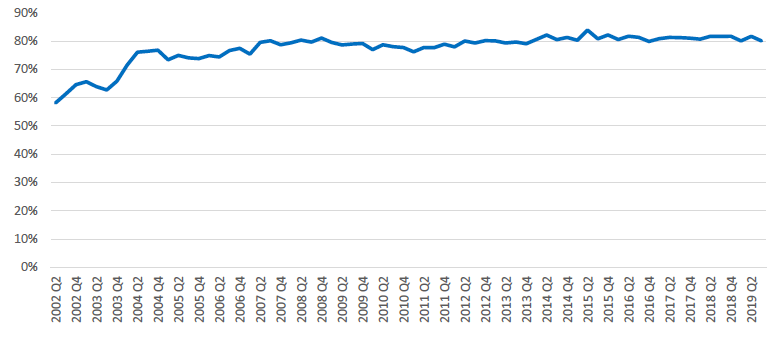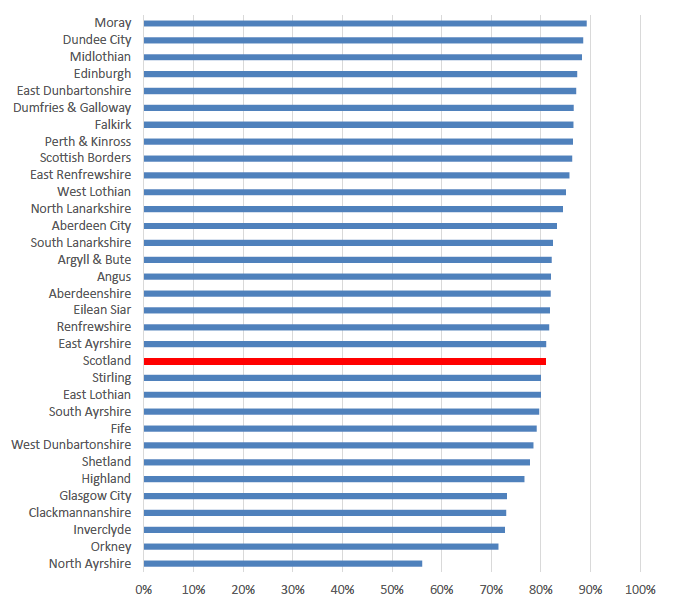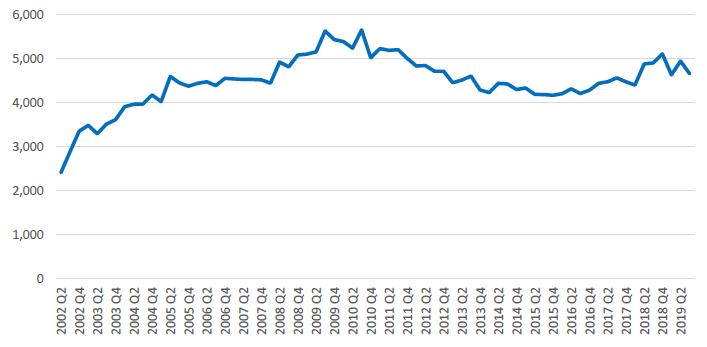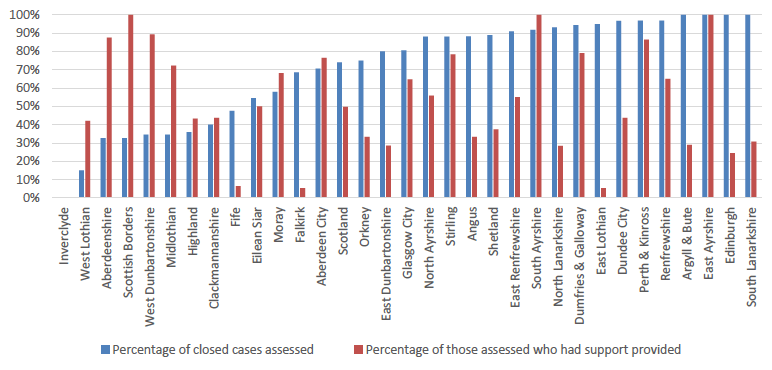Homelessness in Scotland: update to 30 September 2019
This bulletin provides information on local authority homelessness applications, assessments and outcomes in the period from 1 April to 30 September 2019.
This document is part of a collection
Outcomes
(Tables 19 to 22)
Overall outcomes
Contact was maintained for 94% of cases that were unintentionally homeless and 95% that were intentionally homeless between 1 April and 30 September 2019 (Table 19).
Table 20 shows that, between 1 April and 30 September 2019, settled accommodation (a tenancy with a local authority, a registered social landlord or a private tenancy) was secured for 10,070 (81%) of the 12,455 applications where cases were assessed as unintentionally homeless and the outcome was known. As Chart 14 shows, this proportion has remained stable over time.
Chart 14: Proportion of cases assessed as unintentionally homeless and where contact was maintained securing settled accommodation

Looking at all types of settled accommodation used during the past six months (April to September 2019), Table 20 shows that (where outcome was known) Local Authority accommodation comprises almost half (43%) of all outcomes for unintentionally homeless households. Over a quarter (28%) of unintentionally homeless households secured Registered Social Landlord (RSL) accommodation with private rented accommodation taken up in 5% of cases. 18% of cases assessed as homeless had other outcomes, including return to previous accommodation (5%), moved in with friends/family (4%), other ‘known’ outcome (8%) and hostel (less than 1%).
However note that these percentages can vary between local authorities, for example the proportion of cases securing settled accommodation in the latest 6 month period varies between 56% in North Ayrshire to 89% in Moray (Table 21). The 6 stock transfer authorities of Argyll & Bute, Dumfries & Galloway, Glasgow, Inverclyde, Eilean Siar and Scottish Borders do not have council housing stock to manage following the transfer of social housing stock to housing associations, and therefore settled accommodation with the social sector will generally be to housing association properties rather than local authority properties. The proportion of cases securing settled accommodation in the private rented sector ranges between 0% in Eilean Siar and Inverclyde to 19% in Edinburgh.
Chart 15: Percentage of households assessed as unintentionally homeless securing settled accommodation, April to September 2019

Social Lets
The number of homeless households securing a social let from either a local authority or housing association increased from around 2,400 in the April to June quarter in 2002 (Q2) to a peak of over 5,600 in the July-September quarter of 2010 (Q3). The total number of social lets to homeless households has since fallen back from this peak to around 4,200 in 2015, though has risen again since then, reaching 5,110 in 2018 (see Chart 16).
Chart 16: Number of households assessed as unintentionally homeless whose outcome was a social let

Note that Chart 16 is based on outcomes for all applications, regardless of assessment decision or whether contact was maintained until duty discharge.
Housing support regulations
Table 22 shows that during the 6 month period from 1 April to 30 September 2019, there were 13,285 cases assessed as unintentionally homeless or threatened with homelessness that were closed in this period. Of these, 9,825 (74%) were recorded as being assessed under the housing support regulations, of which 4,890 (50%) had support provided and 4,285 (44%) did not require any support.
There are large variations across Local Authorities in the proportions who are making assessments under the regulations and the number to whom support is provided. Some authorities are making assessments for all their closed cases, namely Argyll and Bute, East Ayrshire, Edinburgh and South Lanarkshire. This is in contrast to other authorities who are recording a low proportion of assessments under the regulations, including Aberdeenshire (33%), Scottish Borders (33%) and West Lothian (15%). In Inverclyde, none of the 60 cases had support provided.
What appears to be even more variable is the extent to which support is then being provided: there are examples where a large majority of those assessed have support provided Easy Ayrshire, Scottish Borders and South Ayrshire (all 100%)). Conversely, in other local authorities, for example, East Lothian (5%), Falkirk (5%) and Fife (6%), a very small proportion of those assessed under the regulations go on to receive support (see Chart 17).
Chart 17: Unintentionally homeless or threatened with homelessness assessed under Housing Support regulations, April to September 2019

Note: Eligible closed cases are defined as those assessed as unintentionally homeless or threatened with homelessness and that there is a 'reason to believe' that they need the housing support services prescribed in regulations.
The legislation which established the housing support duty (Section 32B of the Housing (Scotland) Act 1987 inserted by Housing (Scotland) Act 2010) states that there is a duty for Local Authorities to conduct a housing support assessment for applicants who are unintentionally homeless or threatened with homelessness and which they have 'reason to believe' need the housing support services prescribed in regulations.
'The regulations' are the Housing Support Services (Homelessness) (Scotland) Regulations 2012[9] and were established after public consultation. The services prescribed are:
(a) advising or assisting a person with personal budgeting, debt counseling or in dealing with welfare benefit claims;
(b) assisting a person to engage with individuals, professionals or other bodies with an interest in that person's welfare;
(c) advising or assisting a person in understanding and managing their tenancy rights and responsibilities, including assisting a person in disputes about those rights and responsibilities; and
(d) advising or assisting a person in settling into a new tenancy.
If an assessment of a need for support is made, Local Authorities must ensure the assessment is made and housing support services are provided if required. If this assessment is made, an assessment also needs to be made for others that reside with the applicant as part of their household.
The legislation states that 'housing support services' include any service which provides support, assistance, advice or counseling to an individual with particular needs with a view to enabling that individual to occupy, or to continue to occupy, residential accommodation as the individual's sole or main residence. The form and duration of housing support will vary depending on the individual's circumstances and/or those of the people in the household.
Please note: All of the tables in this publication are available in electronic format at: https://www.gov.scot/collections/homelessness-statistics/
Contact
There is a problem
Thanks for your feedback